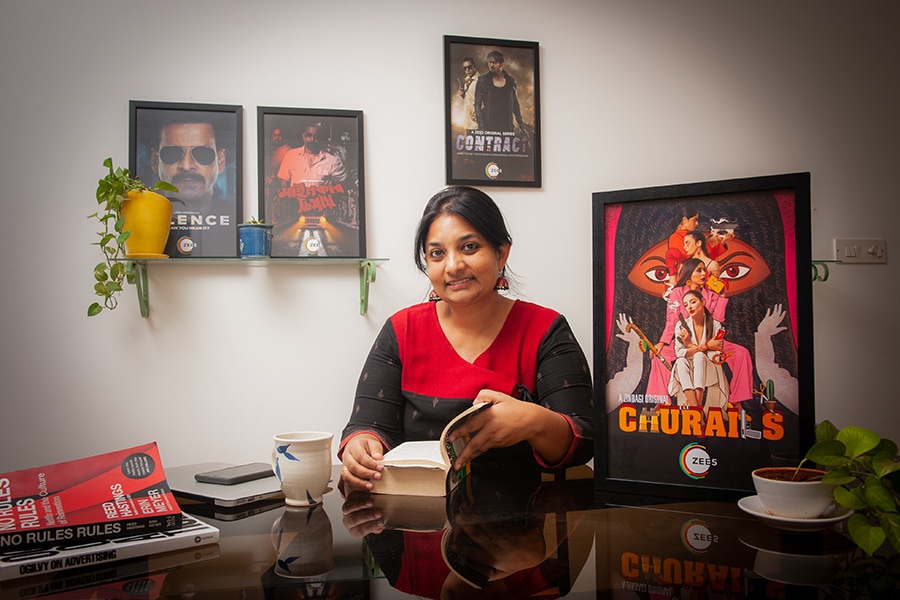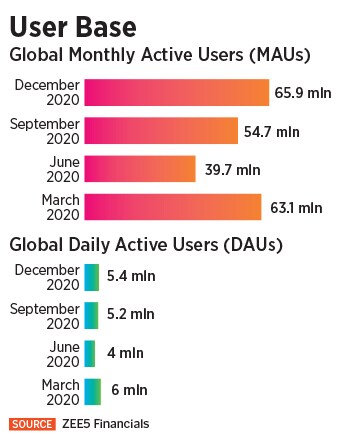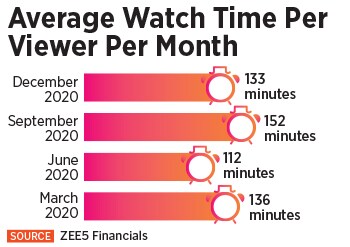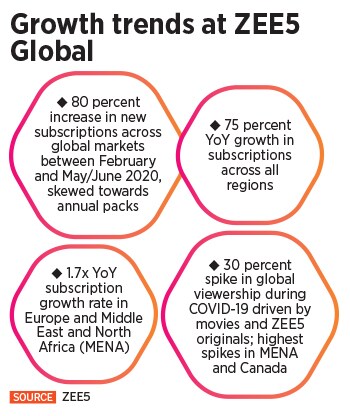Based out of Mumbai, Archana Anand heads ZEE5’s global operations, which include skeletal teams in key markets, in more than 190 countries across the world. The OTT platform, which was launched in February 2018, caters to about 40 million members of the South Asian diaspora. In a conversation with Forbes India, Anand spoke about the challenges of operating in territories with different regulations, ZEE5’s partnership with ALTBalaji, dealing with censorship and protecting children online.
We first launched in February 2018 across the SAARC markets which have an affinity for the kind of content we create. After that, the next stop is going to the rest of APAC. Subsequently, we went to MENA that again has a huge affinity with Indians, Pakistanis and Bangladeshis alike that make up the mix, and absolutely love Bollywood. After MENA, we went across to Europe where UK is obviously one of our key markets. And we’re just on the verge of going loud in Canada and USA.
In terms of revenue, which territories are most profitable?
It is pretty even-steven. We have a freemium model across the globe, that is, a combination of ad-supported content and key content that sits behind a subscription. For example, Bangladesh is a very heavily advertising video on demand (AVOD) skewed market where there’s a far greater affinity for ad-supported [content]. It is a market that is pre-India and pre-Jio days India in its sensibility and therefore not sophisticated on the digitisation side, and not yet that comfortable with digital payments. While subscription is still a growing trend, our focus is completely on an ad-supported model despite having both models in all markets.
All the first world markets—whether it is all of Europe, UK, Canada—, on the other hand, are very strongly subscription markets.
In the Middle East, you have a very even [distribution of audience]. It’s mobile-savvy, and we have a huge audience that’s watching the ad-supported content, but also there is a propensity and understanding to pay.
On the APAC side, it is too fragmented. On the one side, you have Bangladesh, Pakistan, Sri Lanka, which are one sensibility, on the other side, you have excessively sophisticated digital markets, like Japan, or Hong Kong, or Singapore, or Australia or New Zealand. And, therefore, it"s very, very disparate.
![archana anand-1 archana anand-1]()
What is the scene with Africa, especially now that Netflix is producing movies such as Namaste Wahala, a crossover between the Hindi and Nigerian film industries?
We will probably not enter Africa aggressively this year, but it is very much on our radar. It is doing very well for us on the linear television side, and we are already kind of present in South Africa in a nascent form. Were we to get into Africa—when we do and it is a part of our future plans—South Africa, Kenya, and Nigeria all remain excessively key markets. We are very keenly watching what Netflix is doing.
Which markets have the highest number of subscribers?
At this point, I am excessively happy about the kind of subscriptions I am getting from Europe and Canada. Then it would be the Middle East region. And then, of course, the APAC market. APAC has a lot of volume because there are telco partnerships going right across. For example, in Bangladesh, I am tied across all the telcos, whether it"s Robi or Grameenphone, and I get huge volumes. I even sell daily and
weekly packs but my ARPUs [average revenue per user] are low. In the Western markets, I have really high ARPUs. I am not only selling at high rates, I am selling annual packs across and recurring subscription is quite the norm globally. Thus, realising up to $10 to $12 per consumer is very much the norm in those markets.
What kind of content is most successful in overseas markets?
We’ve seen both our movies and our original series doing really well. But during Covid-19, movies were quite the rage and garnered us tremendous potential. We also saw some interesting insights. Sadly, with the Sushant Singh thing that happened, one of his earlier library shows with us, Pavitra Rishta, got incredible amount of love across the globe. That shot our viewership and our views right through the roof. We have had some sporadic things like this, but the library shows did really well during the lockdown period when we were really strapped in terms of content creation. But otherwise, our movies have done really well and some of our key originals. Churails, the women-centric Pakistani original, did supremely well, Chintu ka Birthday, Mee Raqsam, some of these stories completely rooted in reality, did really well. Then there was Mainkar Chipay, a Bangladeshi original we did, very Quentin Tarantino in style, which did well. Then the main originals—Baarish, Abhay, Karle Tu Bhi Mohabbat.
![archana anand-2 archana anand-2]()
Some of these shows are ALTBalaji shows as well. How has that partnership played out for you? [In July 2019, ZEE5 and ALTBalaji had signed a deal to co-create more than 60 original series in Hindi that would be made available on both platforms.]
Well, it has been a mixed bag. There is some that did really well. For instance, Mission on Mars, Code M, Coldd Lassi Aur Chicken Masala [sic], Baarish, Karle Tu Bhi Mohabbat.
Did you see any trends vis-à-vis the popularity of certain genres or certain kinds of content doing well in certain regions?
I think romance, relationship, family dramas, such content cut cross board. Relatively newer takes on relationships, such as in Coldd Lassi And Chicken Masala, as well as urban settings connect better with our global audience over the age-old serials and soap operas.
How did you deal with the controversy that happened in Pakistan around Churails, where it was first pulled, and then reinstated?
We took our cues from what was happening. We had a directive that asked us to pull it down and we immediately complied because the idea was to comply with the laws of that land because, as a global entity, we are very particular about that in each of the countries we are present in. But subsequently, there was a certain amount of reaction to it, and I don’t know how exactly it played out, but there was a reversal on that. And then we put it back up and it has continued to garner a lot of love.
The State Bank of Pakistan had said at that time that no digital payments can be made towards any Indian OTT platforms.
That still holds good. The rule still stands.
So how is ZEE5 offered in Pakistan today?
In every market, we are available in both forms—free and paid. On the free platform, consumers will still be able to freely access it and watch.
Are you seeing a lot of traffic from Pakistan?
We have always seen a lot of traction from Pakistan. It"s a country that has so much in common with us, that we love their content and I believe there is a fair amount of love for our content.
Are there plans to acquire or license content from other countries as well, including US, Pakistan, UK? In the catalogue, there is of course Indian content that’s available. There are a few originals from Bangladesh and Pakistan.
We really want to be known as the foremost brand for South Asian content across the globe. We have the biggest right to win in that space because apart from the 130,000 hours of Indian content we have on our platform, we are the ones with the most extensive and gorgeous Pakistani library, and we are the first to foray into Bangladesh too in terms of content creation.
What makes Indian content competitive at a global stage?
It is a crowded marketplace but we are very cognisant of the fact that we now want to play in a space where we are competing right out there with the new age audience that has a lot of choice. Because we play in the global space, we are also aware of the changing mindsets when it comes to a first generation, second generation, third generation and so on, or variances between the consumption habits of an NRI as opposed to a PIO who is part native in a sense. Everything that we research and create is really from that sensibility.
![archana anand-3 archana anand-3]()
How do you deal with the public backlash against certain kinds of content? There have been at least three ZEE5 originals where it has happened—XXX Uncensored, which was of course with ALTBalaji, Godman, and certain scenes had to be edited out of Abhay.
With respect to our partnership with ALTBalaji, we are very clear now that the content has to stay within the larger sensibility of the audience we want to chase and the sensibilities that we want to chase, so you won"t find us doing any more of that kind of content.
I think when there are actual sensitivities, we are very clear that we will play by the laws of the land, we are very cognisant of the fact that different cultures have different levels of sensitivity. If there is a disconnect, at the first instance, you will find that we just comply and we will pull it down.
Does that mean that different versions of the same piece of content are available across the ZEE5 platform?
Yes. Wherever we find that there is a region or a country that has a disconnect, we will pull it out down there. For example, when we pulled down Churails in Pakistan, we didn’t pull it down globally.
What are the business consequences of complying with so many different sensibilities, standards and laws?
At some level, it might be a little more in the content space, but generally I think any company or any brand that is present globally, would have the same challenges. You have to comply with the laws of the land, if you choose to want to do business there.
When we go into any country we are very clear that it is a two-way collaborative process wherein both parties need to stand to win, that both have to be deeply respectful of each other"s culture and norms.
![archana anand-4 archana anand-4]()
Given the frequency with which public backlash against OTT content has been playing out, not just in India, but potentially across the world—for instance, with Cuties on Netflix in the US, or with Tandav or Bombay Begums on Netflix— , do you think that has had an impact on creative freedom?
I think it is two parts. On the one hand, there is creative freedom and obviously OTT has taken creative freedom many, many notches up from what television had in terms of its scope. But at the same time, one has to be respectful of the fact that it is open access, and therefore, people of all age groups can actually access it. I think it is only responsible for OTTs to put in place age classification and age-gating. I don’t think it is about censorship, but about ensuring that if you are given creative freedom, and there are things that are risqué, then the risqué content is available only to an audience of an appropriate age.
Do you think given the nature of OTT content, which is not push content but pull content, some of the responsibility of ensuring age-appropriate content also lies with the parent or the guardian?
Definitely. It’s like back in the day, we had parental controls over the only desktop at home. But I would say that just by virtue of the fact that every child above 11 or 12 ends up having a smartphone, it may not be right to put all of the onus on the parent. I think it"s fair to have a certain amount of onus on the OTTs to safeguard what will get viewed by different age groups and cohorts.
![archana anand-5 archana anand-5]()
What would be an effective age-gating mechanism there?
There are different things different OTTs do. For example, on Netflix, I can create different profiles and define what is the sort of access possible for each profile and then pretty much nothing else shows. Given that everything can be worked around in the digital universe, and if one is determined to circumvent, there is only so much you can do [as a platform] but yes, basics need to be done at the OTT end.
Given that ZEE5 also has a lot of free content unlike say Netflix, how do you put certain things behind a mechanism so that children cannot access it freely?
Most of our free content is basically what is also running on our linear platforms. And as far as linear platforms are concerned, there are strict protocols in terms of what can be shown to a family or not. Linear content is not even a problem because our philosophy on the linear side is that it has got to be family-oriented content, and you will literally find nothing of the nature that can be suspect.
Under the new Digital Media Code of Ethics, would it be difficult for you to reclassify your entire catalogue according to the five different age-based categories that have been laid down?
That is specific to India and I get to speak to the global side of the business.
Infographics by Sameer Pawar

 Image: Neha Mithbawkar
Image: Neha Mithbawkar



